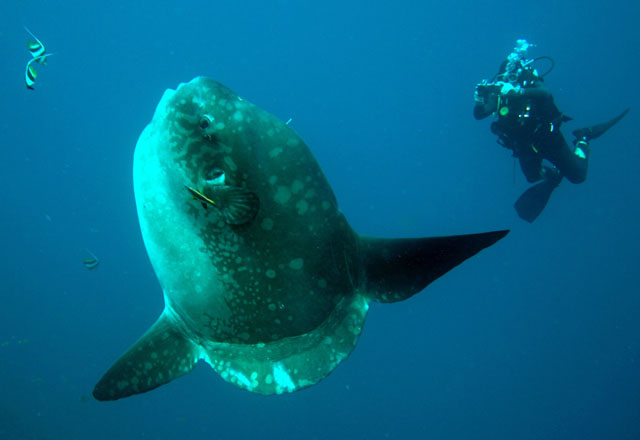| Molidae (Molas or Ocean Sunfishes) |
| 333 cm TL (male/unsexed); max.weight: 2,300 kg |
|
pelagic-oceanic; depth range 30 - 480 m, oceanodromous |
| Warm and temperate zones of all oceans. Eastern Pacific: British Columbia, Canada (Ref. 2850) to Peru and Chile (Ref. 5530). Western Pacific: Japan to Australia (Ref. 86345). Eastern Atlantic: Scandinavia to South Africa (occasionally western Baltic, Mediterranean). Western Atlantic: Newfoundland, Canada (Ref. 7251) to Argentina (Ref. 36453). |
|
Dorsal spines (total): 0-0; Dorsal soft rays (total): 15-18; Anal spines: 0-0; Anal soft rays: 14-17. The scaleless body is covered with extremely thick, elastic skin. The caudal fin is replaced by a rudder-like structure called 'clavus'. Dorsal and anal fins very high with short base; in swimming, these fins are flapped synchronously from side to side and can propel the fish at surprisingly good speed. Pectorals small and rounded, directed upward (Ref. 6885). Mouth very small; teeth fused to form a parrot-like beak. Gills 4, a slit behind the last; gill openings reduced to a small hole at the base of the pectoral fins. Gas bladder absent in adults.
Description: Characterized further by deep and oval body, nearly circular, depth 1-1.5 in TL; rough texture of skin; clavus supported by about 12 fin rays, of which 8-9 bear ossicles (Ref. 90102). |
| Molas are distinguished for their distinct morphological characters which include reduced/fused caudal elements, presence of a clavus in place of the caudal fin, absence of a swim bladder and a degenerate, cartilaginous skeleton (Ref. 86435). Adults are found on slopes adjacent to deep water where they come in for shelter and for seeking cleaner fishes. They are usually shy. However, they may become familiar with divers in some locations (Ref. 48637). Individuals often drift at the surface while lying on its side but can swim actively and are capable of directional movements otherwise (Ref. 86435). They swim upright and close to the surface. The dorsal fin often protrudes above the water. Females are larger than males (Ref. 86435). This species has been filmed in 480 m depth with the help of a camera equipped with baits (Lis Maclaren, pers. comm. 2005). Adults eat fishes, mollusks, zooplankton, jellyfish, crustaceans and brittle stars (Ref. 4925, 5951, 48637). A live colony of the cirripede Lepas anatifera were found attached to the anterior portion of the sunfish's esophagus that was stranded in the south coast of Terceira Island, Azores Archipelago in 2004. This association has apparent advantages for the goose barnacles such as a regular intake of food and protection both from hydrodynamic hazards and from predators: but for the sunfish, it is not clear whether it is neutral, of advantage or causes feeding problems since the attachment may obstruct the sunfish's esophagus (Ref. 55063). The sunfish is registered as the heaviest bony fish and as the one with the most eggs in the Guinness Book of World Records (Ref. 6472). Generally this species is not used as food fish; some people consider it as a delicacy (Ref. 30573). The fish can be utilized fresh and can be broiled (Ref. 9988). Some parts of the fish are used in Chinese medicine (Ref. 12166). Molas may contain the same toxin as puffers and porcupine fish (Ref. 13513). They do not adapt well in captivity (Ref. 12382, 37040). Juveniles are victims of California sea lions in Monterey Bay (Ref. 37040). |
|
Vulnerable (A4bd)
(Ref. 96402)
|
| poisonous to eat |
|
Source and more info: www.fishbase.org. For personal, classroom, and other internal use only. Not for publication.
Page created by Jen, 05.08.02,
php script by kbanasihan 06/09/2010 ,
last modified by
dsantos, 20/08/10

